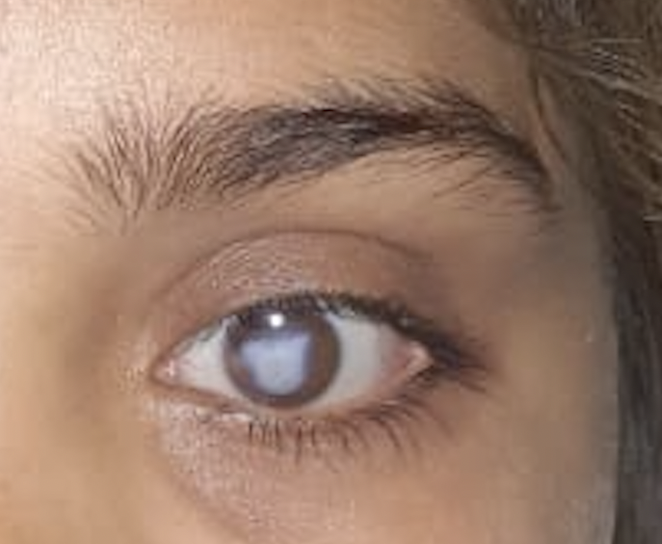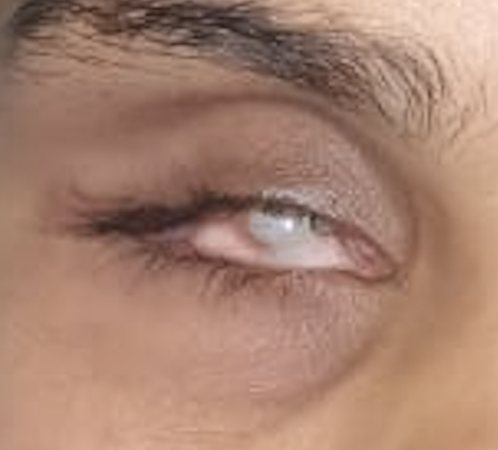[1]
Vashist P, Senjam SS, Gupta V, Gupta N, Kumar A. Definition of blindness under National Programme for Control of Blindness: Do we need to revise it? Indian journal of ophthalmology. 2017 Feb:65(2):92-96. doi: 10.4103/ijo.IJO_869_16. Epub
[PubMed PMID: 28345562]
[2]
Shah P, Schwartz SG, Gartner S, Scott IU, Flynn HW Jr. Low vision services: a practical guide for the clinician. Therapeutic advances in ophthalmology. 2018 Jan-Dec:10():2515841418776264. doi: 10.1177/2515841418776264. Epub 2018 Jun 11
[PubMed PMID: 29998224]
Level 3 (low-level) evidence
[3]
Şahlı E, İdil A. A Common Approach to Low Vision: Examination and Rehabilitation of the Patient with Low Vision. Turkish journal of ophthalmology. 2019 Apr 30:49(2):89-98. doi: 10.4274/tjo.galenos.2018.65928. Epub
[PubMed PMID: 31055894]
[4]
Hu CX, Zangalli C, Hsieh M, Gupta L, Williams AL, Richman J, Spaeth GL. What do patients with glaucoma see? Visual symptoms reported by patients with glaucoma. The American journal of the medical sciences. 2014 Nov:348(5):403-9. doi: 10.1097/MAJ.0000000000000319. Epub
[PubMed PMID: 24992392]
[5]
National Research Council (US) Committee on Disability Determination for Individuals with Visual Impairments, Lennie P, Van Hemel SB. Visual Impairments: Determining Eligibility for Social Security Benefits. 2002:():
[PubMed PMID: 25032291]
[6]
Chakravarthy U, Bailey CC, Johnston RL, McKibbin M, Khan RS, Mahmood S, Downey L, Dhingra N, Brand C, Brittain CJ, Willis JR, Rabhi S, Muthutantri A, Cantrell RA. Characterizing Disease Burden and Progression of Geographic Atrophy Secondary to Age-Related Macular Degeneration. Ophthalmology. 2018 Jun:125(6):842-849. doi: 10.1016/j.ophtha.2017.11.036. Epub 2018 Feb 1
[PubMed PMID: 29366564]
[7]
Larsen PP, Thiele S, Krohne TU, Ziemssen F, Krummenauer F, Holz FG, Finger RP, OVIS-Study Group. Visual impairment and blindness in institutionalized elderly in Germany. Graefe's archive for clinical and experimental ophthalmology = Albrecht von Graefes Archiv fur klinische und experimentelle Ophthalmologie. 2019 Feb:257(2):363-370. doi: 10.1007/s00417-018-4196-1. Epub 2018 Nov 27
[PubMed PMID: 30483949]
[9]
Dandona L,Dandona R, Revision of visual impairment definitions in the International Statistical Classification of Diseases. BMC medicine. 2006 Mar 16;
[PubMed PMID: 16539739]
[10]
Wolfram C, Schuster AK, Elflein HM, Nickels S, Schulz A, Wild PS, Beutel ME, Blettner M, Münzel T, Lackner KJ, Pfeiffer N. The Prevalence of Visual Impairment in the Adult Population. Deutsches Arzteblatt international. 2019 Apr 26:116(17):289-295. doi: 10.3238/arztebl.2019.0289. Epub
[PubMed PMID: 31196384]
[11]
Foster A, Resnikoff S. The impact of Vision 2020 on global blindness. Eye (London, England). 2005 Oct:19(10):1133-5
[PubMed PMID: 16304595]
[12]
Pascolini D, Mariotti SP. Global estimates of visual impairment: 2010. The British journal of ophthalmology. 2012 May:96(5):614-8. doi: 10.1136/bjophthalmol-2011-300539. Epub 2011 Dec 1
[PubMed PMID: 22133988]
[13]
Hussain AHME, Ferdoush J, Mashreky SR, Rahman AKMF, Ferdausi N, Dalal K. Epidemiology of childhood blindness: A community-based study in Bangladesh. PloS one. 2019:14(6):e0211991. doi: 10.1371/journal.pone.0211991. Epub 2019 Jun 7
[PubMed PMID: 31173584]
[14]
Ackland P, Resnikoff S, Bourne R. World blindness and visual impairment: despite many successes, the problem is growing. Community eye health. 2017:30(100):71-73
[PubMed PMID: 29483748]
[15]
Wadhwani M, Vashist P, Singh SS, Gupta V, Gupta N, Saxena R. Prevalence and causes of childhood blindness in India: A systematic review. Indian journal of ophthalmology. 2020 Feb:68(2):311-315. doi: 10.4103/ijo.IJO_2076_18. Epub
[PubMed PMID: 31957718]
Level 1 (high-level) evidence
[16]
Vashist P, Senjam SS, Gupta V, Gupta N, Shamanna BR, Wadhwani M, Shukla P, Manna S, Yadav S, Bharadwaj A. Blindness and visual impairment and their causes in India: Results of a nationally representative survey. PloS one. 2022:17(7):e0271736. doi: 10.1371/journal.pone.0271736. Epub 2022 Jul 21
[PubMed PMID: 35862402]
Level 3 (low-level) evidence
[17]
GBD 2019 Blindness and Vision Impairment Collaborators, Vision Loss Expert Group of the Global Burden of Disease Study. Causes of blindness and vision impairment in 2020 and trends over 30 years, and prevalence of avoidable blindness in relation to VISION 2020: the Right to Sight: an analysis for the Global Burden of Disease Study. The Lancet. Global health. 2021 Feb:9(2):e144-e160. doi: 10.1016/S2214-109X(20)30489-7. Epub 2020 Dec 1
[PubMed PMID: 33275949]
[18]
Rao GN, Sabnam S, Pal S, Rizwan H, Thakur B, Pal A. Prevalence of ocular morbidity among children aged 17 years or younger in the eastern India. Clinical ophthalmology (Auckland, N.Z.). 2018:12():1645-1652. doi: 10.2147/OPTH.S171822. Epub 2018 Sep 6
[PubMed PMID: 30233126]
[19]
Courtright P, West SK. Contribution of sex-linked biology and gender roles to disparities with trachoma. Emerging infectious diseases. 2004 Nov:10(11):2012-6
[PubMed PMID: 15550216]
[20]
Habtamu E, Wondie T, Aweke S, Tadesse Z, Zerihun M, Zewdie Z, Callahan K, Emerson PM, Kuper H, Bailey RL, Mabey DC, Rajak SN, Polack S, Weiss HA, Burton MJ. Trachoma and Relative Poverty: A Case-Control Study. PLoS neglected tropical diseases. 2015 Nov:9(11):e0004228. doi: 10.1371/journal.pntd.0004228. Epub 2015 Nov 23
[PubMed PMID: 26600211]
Level 2 (mid-level) evidence
[21]
Lozada KN, Cleveland PW, Smith JE. Orbital Trauma. Seminars in plastic surgery. 2019 May:33(2):106-113. doi: 10.1055/s-0039-1685477. Epub 2019 Apr 26
[PubMed PMID: 31037047]
[22]
Avogaro A, Fadini GP. Microvascular complications in diabetes: A growing concern for cardiologists. International journal of cardiology. 2019 Sep 15:291():29-35. doi: 10.1016/j.ijcard.2019.02.030. Epub 2019 Feb 25
[PubMed PMID: 30833106]
[24]
Musch DC, Niziol LM, Gillespie BW, Lichter PR, Janz NK. Binocular Measures of Visual Acuity and Visual Field versus Binocular Approximations. Ophthalmology. 2017 Jul:124(7):1031-1038. doi: 10.1016/j.ophtha.2017.02.013. Epub 2017 Apr 10
[PubMed PMID: 28408039]
[25]
Moshirfar M, Murri MS, Shah TJ, Skanchy DF, Tuckfield JQ, Ronquillo YC, Birdsong OC, Hofstedt D, Hoopes PC. A Review of Corneal Endotheliitis and Endotheliopathy: Differential Diagnosis, Evaluation, and Treatment. Ophthalmology and therapy. 2019 Jun:8(2):195-213. doi: 10.1007/s40123-019-0169-7. Epub 2019 Mar 11
[PubMed PMID: 30859513]
[27]
Shrestha GS, Sigdel R, Shrestha JB, Sharma AK, Shrestha R, Mishra SK, Joshi SN. Awareness of Eye Health and Diseases among the Population of the Hilly Region of Nepal. Journal of ophthalmic & vision research. 2018 Oct-Dec:13(4):461-469. doi: 10.4103/jovr.jovr_41_17. Epub
[PubMed PMID: 30479718]
[28]
Wang BZ, Pesudovs K, Keane MC, Daly A, Chen CS. Evaluating the effectiveness of multidisciplinary low-vision rehabilitation. Optometry and vision science : official publication of the American Academy of Optometry. 2012 Sep:89(9):1399-408. doi: 10.1097/OPX.0b013e3182678d82. Epub
[PubMed PMID: 22902419]
[29]
Owsley C, McGwin G Jr, Lee PP, Wasserman N, Searcey K. Characteristics of low-vision rehabilitation services in the United States. Archives of ophthalmology (Chicago, Ill. : 1960). 2009 May:127(5):681-9. doi: 10.1001/archophthalmol.2009.55. Epub
[PubMed PMID: 19433720]
[30]
Verma R, Khanna P, Prinja S, Rajput M, Arora V. The national programme for control of blindness in India. The Australasian medical journal. 2011:4(1):1-3. doi: 10.4066/AMJ.2011.505. Epub 2011 Jan 31
[PubMed PMID: 23393496]
[31]
Khan MA, Soni M, Khan MD. Development of primary eye care as an integrated part of comprehensive health care. Community eye health. 1998:11(26):24-6
[PubMed PMID: 17492028]
[32]
Patel D. The role of secondary level eye care teams in engaging with and supporting primary eye care. Community eye health. 2021:34(113):77-78
[PubMed PMID: 36033412]
[33]
Al Motowa S, Khandekar R, Al-Towerki A. Resources for eye care at secondary and tertiary level government institutions in Saudi Arabia. Middle East African journal of ophthalmology. 2014 Apr-Jun:21(2):142-6. doi: 10.4103/0974-9233.129761. Epub
[PubMed PMID: 24791105]
[34]
Muhoozi GKM, Atukunda P, Diep LM, Mwadime R, Kaaya AN, Skaare AB, Willumsen T, Westerberg AC, Iversen PO. Nutrition, hygiene, and stimulation education to improve growth, cognitive, language, and motor development among infants in Uganda: A cluster-randomized trial. Maternal & child nutrition. 2018 Apr:14(2):e12527. doi: 10.1111/mcn.12527. Epub 2017 Sep 19
[PubMed PMID: 28925580]
Level 1 (high-level) evidence
[35]
Gurnani B, Srinivasan K, Venkatesh R, Kaur K. Do motivational cards really benefit sibling screening of primary open-angle glaucoma probands? Indian journal of ophthalmology. 2022 Dec:70(12):4158-4163. doi: 10.4103/ijo.IJO_1346_22. Epub
[PubMed PMID: 36453305]
[36]
Gurnani B, Christy J, Narayana S, Rajkumar P, Kaur K, Gubert J. Retrospective multifactorial analysis of Pythium keratitis and review of literature. Indian journal of ophthalmology. 2021 May:69(5):1095-1101. doi: 10.4103/ijo.IJO_1808_20. Epub
[PubMed PMID: 33913840]
Level 2 (mid-level) evidence
[37]
Gurnani B, Narayana S, Christy J, Rajkumar P, Kaur K, Gubert J. Successful management of pediatric pythium insidiosum keratitis with cyanoacrylate glue, linezolid, and azithromycin: Rare case report. European journal of ophthalmology. 2022 Sep:32(5):NP87-NP91. doi: 10.1177/11206721211006564. Epub 2021 Mar 28
[PubMed PMID: 33779337]
Level 3 (low-level) evidence
[38]
Gurnani B, Kaur K, Venugopal A, Srinivasan B, Bagga B, Iyer G, Christy J, Prajna L, Vanathi M, Garg P, Narayana S, Agarwal S, Sahu S. Pythium insidiosum keratitis - A review. Indian journal of ophthalmology. 2022 Apr:70(4):1107-1120. doi: 10.4103/ijo.IJO_1534_21. Epub
[PubMed PMID: 35325996]
[39]
Gurnani B, Kaur K, Agarwal S, Lalgudi VG, Shekhawat NS, Venugopal A, Tripathy K, Srinivasan B, Iyer G, Gubert J. Pythium insidiosum Keratitis: Past, Present, and Future. Ophthalmology and therapy. 2022 Oct:11(5):1629-1653. doi: 10.1007/s40123-022-00542-7. Epub 2022 Jul 5
[PubMed PMID: 35788551]
[40]
Sabel BA, Wang J, Cárdenas-Morales L, Faiq M, Heim C. Mental stress as consequence and cause of vision loss: the dawn of psychosomatic ophthalmology for preventive and personalized medicine. The EPMA journal. 2018 Jun:9(2):133-160. doi: 10.1007/s13167-018-0136-8. Epub 2018 May 9
[PubMed PMID: 29896314]
[41]
Prasad S, Galetta SL. Approach to the patient with acute monocular visual loss. Neurology. Clinical practice. 2012 Mar:2(1):14-23. doi: 10.1212/CPJ.0b013e31824cb084. Epub
[PubMed PMID: 29443297]
[42]
Stevens S. Assisting the blind and visually impaired: guidelines for eye health workers and other helpers. Community eye health. 2003:16(45):7-9
[PubMed PMID: 17491861]
[43]
Demmin DL, Silverstein SM. Visual Impairment and Mental Health: Unmet Needs and Treatment Options. Clinical ophthalmology (Auckland, N.Z.). 2020:14():4229-4251. doi: 10.2147/OPTH.S258783. Epub 2020 Dec 3
[PubMed PMID: 33299297]


